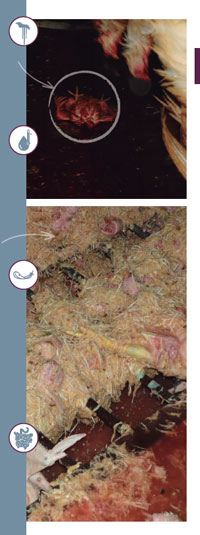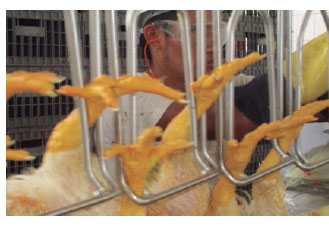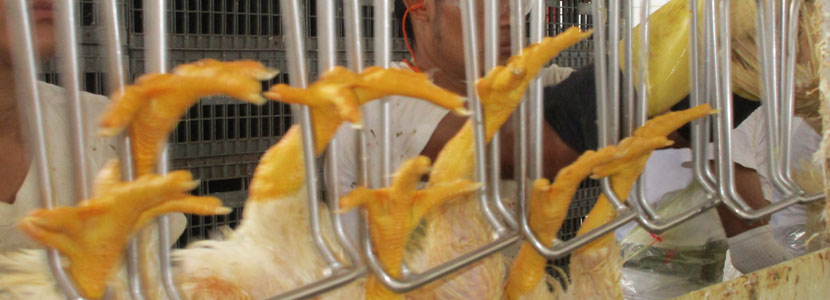Content available at: Español (Spanish) Português (Portuguese (Brazil))
Traditionally, the focus of the chicken processing plants is to reduce seizures. These are defined as the partial or total withdrawals of the broilers, the result of inadequate management during pre-slaughter and slaughter operations. During the visits to the processing plants, another control point is observed mainly on the equipment and the floors.
The purpose of this article is to invite readers to control the losses in performance, including what’s known as “Waste”, which in some plants comes to represent as a significant amount of prime kilos ending up at the by-product processor.
Why do they originate?
For example, we have observe the following scenarios:
- Although the hooks are adequate for the weight of the birds to be slaughtered, the staff does not bring the legs to the bottom of the hooks.
- Large chickens – weighing over 3.0 kilos – with thicker legs that are being processed. This thickness causes the legs to not properly reach the bottom of the hooks.
As the legs are not properly supported, some chickens fall in the following stages of the process:
- Bleeding
- Scalding
- Plucking
- Evisceration

Blood Tunnel
Depending on the speed of the process and the characteristics of this area, in many cases the birds cannot be picked up to be collected and get covered in blood. For this reason they end up at the plant where the by-products are processed.
Scalding
Due to the turbulence of the water; which is used to widen feather follicle, many chickens fall from the hooks. At the end of the process, once the tanks have been emptied, the carcasses appear to be fully cooked. This represents another circumstance of raw material that the by-product processor receives.
Plucking
The rotation of the finger discs as the birds pass by makes it easier for them to fall. In many plants, feathers are collected using conveyor belts that move them out of the plant, where they are temporarily stored in hoppers. In other cases, the chickens fall directly into the trough on the floor. A continuous re-circulation of water drags the feathers along with the dropped chickens to another section where they are temporarily stored in hoppers.
Evisceration
The positioning of the birds in the equipment that make up the automatic infrastructure is sometimes not adequate. That is why, during the operation of the machines, the chickens fall on the collecting tray located at the bottom. In other cases, they end up on the floor. Sanitary regulations in some countries – especially those that prepare products for export – do not allow reprocessing.
Inefficient infrastructure
The processing of the birds requires them to be moved by hanging on overhead conveyors throughout the processing. Therefore, a channel network must be available in some sections in the evisceration area.
Sometimes it is observed that collecting channels; especially between the different machines, are not installed. When the birds drop from the hooks, they fall to the ground and get contaminated. Depending on how strict the health regulations are, there are situations in which reprocessing is not accepted.
A similar situation occurs with giblets: livers, hearts, gizzards, neck and legs.

CHOPPING AND DEBONING SECTION
For some plants, the chopping and deboning section represents a high waste risk area. The following details are observed:
Parts
They are mobilized by conveyor belts that leads them to loading containers. However, during the process they fall to the ground due to the channel or slide section being too short and narrow. If there is a piling of the pieces, they will overflow from the sides of the channel/slide, also falling to the ground.
Boneless meat
They are also transported by belts. By not having the proper width, we cause small pieces to lodge under the band. They continue to get stuck until they fall to the floor or their texture gets affected, and get sent to the tank where the waste is deposited.
Solutions for this expensive problem
CHICKENS FALLING FROM HOOKS ON THE SLAUGHTER OVERHEAD CONVEYOR.
Fortunately, there are already expandable hooks that allow the legs to slide completely to the bottom. The retractable restraint system ensures that the chickens do not fall out during the bleeding, scalding and plucking operations. As a result of this redesign, the hooks also ensure that as the chickens pass through the pluckers, the two legs remain properly positioned. Because of this, the problem of placing people at the exit of the last plucker; so that they put the legs back on the hook, gets solved. Consequently, the chickens arrive at the leg cutter well positioned.

- The ergonomic conditions of the staff that hangs the chickens on the overhead conveyor. Also the method of work applied. Both aspects must be adequate.
- Daily use of the hooks causes the area where the stumps slide to expand. This affects the level of grip required. To verify this critical condition is a task that must be undertaken daily by the personnel responsible for managing the plant and specifically the evisceration area, together with the maintenance group.
- In order to prevent the gibblets i.e: livers, hearts, gizzards from falling on the floor, the path of these products through the trays, channels and ducts, their movement must be fluid, with no interruptions and bottlenecks.
In the chopping and deboning section, the supervisor should be evaluating how operators handle whole chickens and gibblets. The goal is for both flows to move on the conveyor belts. When these parts are not placed on the conveyor surface they pile up and ultimately fall on the floor. A similar situation occurs when the mechanism that removes the bone from the breast becomes out of adjustment and does not unload them into the boxes or tanks.
Workers must handle all saleable parts with a level of performance and great care so that they always move within the plant’s transportation system. Management must also be monitoring every detail that can potentially cause products to fall on the floor. This operational discipline helps to increase the plant’s yiel, and reduce the unit cost of processed products.
















